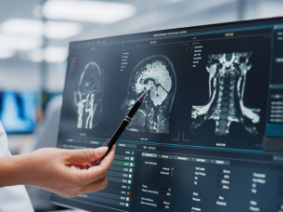A glioma is a type of spinal or brain tumor. These tumors begin in glial cells, which are cells in the central nervous system (CNS) that that support neurons or nerve cells. The term “glial” comes from the Greek word for “glue.” Glial cells are the most common types of cells in the CNS and can be broken down into a variety of subtypes. These include:
- Astrocytes—These cells regulate the central nervous system’s chemical environment.
- Ependymal cells—These cells produce cerebrospinal fluid.
- Oligodendrocytes—These cells produce myelin, which becomes a sheath that protects neurons and nerve cells.
- Microglial cells—These cells clear cellular debris and help heal injuries to the CNS.
A glioma is a cancerous tumor that originates in one of those cell types. Gliomas are subdivided into:
- Astrocytomas, which are the most common type of primary brain tumor and can develop into the very aggressive glioblastoma multiforme.
- Brain stem gliomas, which originate in the cells of the brain stem.
- Ependymomas, which originate in the cells that make spinal fluid.
- Mixed gliomas, which begin in two or more types of glial cells.
- Oligodendrocytomas, which begin in the oligodendrocytes.
Causes
The exact cause of a glioma is not known in most cases. There are, however, a number of factors that increase the risk of developing gliomas, such as:
- Age—While gliomas can happen at any age, most occur between the ages of 45 and 65. Some gliomas, such as brain stem gliomas and ependymomas, are more common in children.
- Family history—A family history of glioma can double a person’s chance of developing one.
- Radiation exposure—Ionizing radiation, such as the type used to treat cancer, can increase the risk of glioma.
Symptoms
Glioma symptoms depend on the type, size and location of the tumor. Some common symptoms can include:
- Balance issues
- Behavior changes
- Changes in cognition
- Confusion
- Dizziness
- Headaches
- Nausea and vomiting
- Personality changes
- Seizures
- Speech changes
- Urinary incontinence
Diagnosis
Doctors will usually start with a medical history and physical exam to determine the presence of symptoms and if there is a family history of glioma. Next is usually a neurological exam, which can include tests for:
- Balance and coordination
- Cognition and memory
- Hearing and speech
- Reflexes
- Strength
- Sensation
- Vision
Some type of imaging test is usually necessary for a firmer diagnosis. These can include magnetic resonance imaging (MRI) or computed tomography (CT) scans. However, a biopsy—taking a small piece of tumor and evaluating it under a microscope—is the only way to truly diagnose a glioma. A biopsy can be done as part of surgery to remove a brain tumor, or it can be done with a stereotactic needle that is inserted into the brain and often guided by an MRI or CT scan.
Treatment
Glioma treatment depends on its grade (severity). While there are four grades, gliomas are often referred to as either low grade (grades I or II) or high grade (grades III or IV). In most cases, surgery to remove all or as much of the tumor as possible is the first step. In many cases, however, the tumor is either too large to fully remove, is located in a particularly sensitive area in the brain or is difficult to access. In such cases, surgeons will remove as much of the tumor as is safely possible.
After surgery, radiation therapy is often the next step. Radiation uses high-energy beams such as X-rays or protons focused on the tumor to destroy cancerous cells. Chemotherapy—medications used to kill cancer cells—is often given in conjunction with radiation.
For more information about gliomas or to schedule an appointment with a specialist, contact us today.



